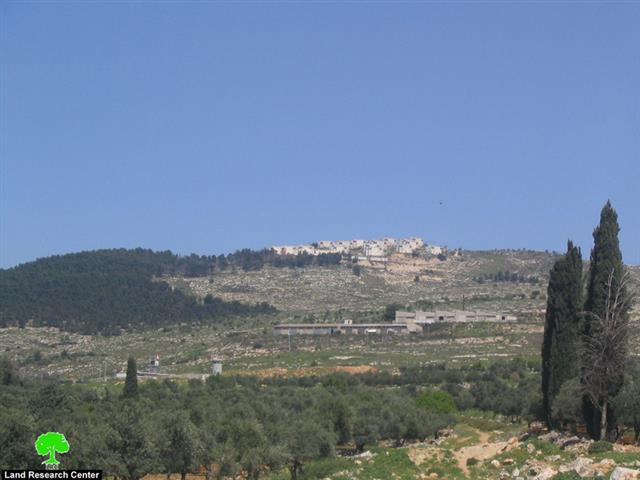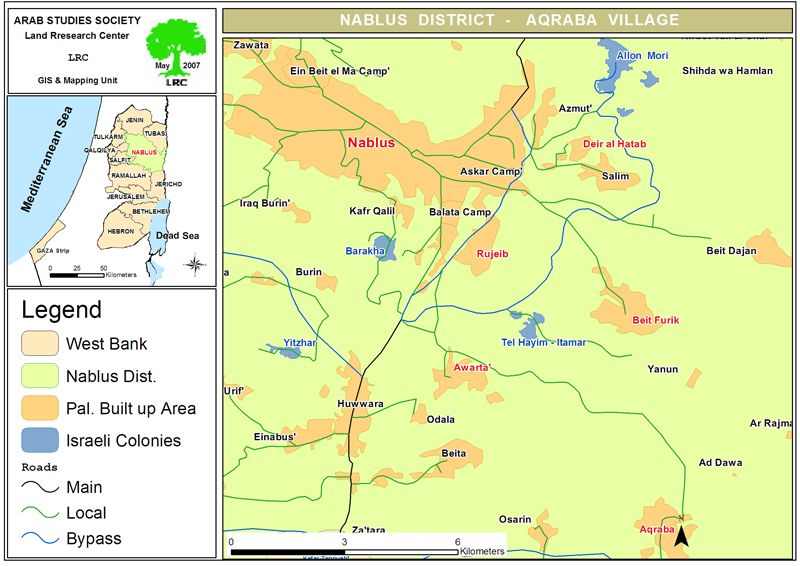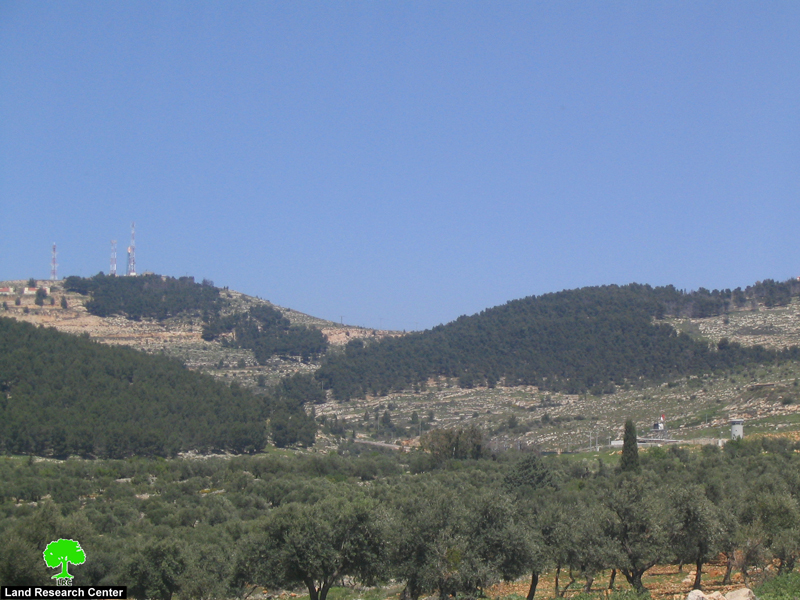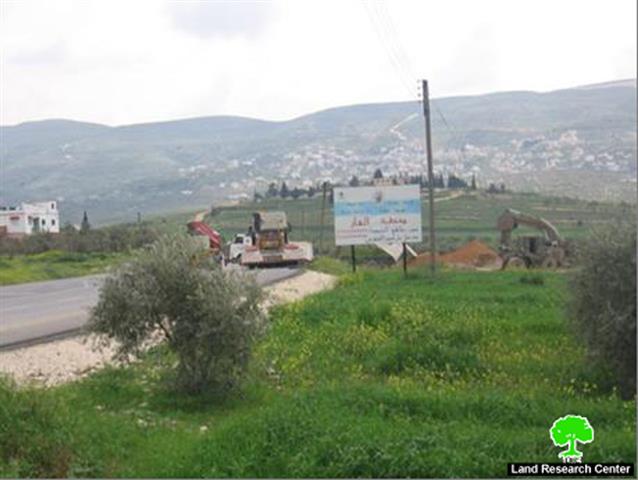The colony of Itamar, which is built on the high mountains near the Palestinian communities of Beit Furik, Awarta and Khirbat Al Yanoon, is considered to be the real tragedy of the Palestinians of 'Awarta and the nearby Palestinian communities. The colony is built in a way as to act as a political and a geographical barrier between the Palestinians of Nablus and the Jordan Valley.
The ex-Israeli Prime Minister, Ehud Barak, has declared during his reign of power the intention of the Israeli government to enlarge the area of the colony ten folds. As a practical move, he placed the corner stone to a military transport line connecting between the colony and the Jordan Valley.
The colony was established in the late 1970s when the so-called Israeli High Court of Justice issued an order to uproot the small colony of Itamar, which was then established on the lands of the Palestinian village of Rujeib, and remove it to its current location on Bilal Ibn Rabah Mountain in Deir al Hatab (a monument of Bilal Ibn Rabah who was prophet Mohammed's Muezzin. The relocation took place using helicopters as the residents of the village still remember the high-flying planes that carried the caravans and placed them atop the mountain where a monument of Bilal Ibn Rabah used to be placed. In 1984, the colony of Itamar was officially declared after it was established on the hands of Yeshiva students from the Ma'eer Institute in Jerusalem. The first name given to the colony was 'Hayeem Hill' in anticipation of 'the resumption of Jewish life' in the location which is considered a religious site as, according to the Israelis, the prophet Itamar Binhas and the seventy elders used to meet.
(Photo1: the colony of Itamar standing at the mountain top)
The colony began slowly but surely to expand after the change of its name from the Hayeem Hill to Itamar in accordance with the recommendation from an extremist professor holding the name of Ze'ev Felna'ee. The expansion continued for the last thirty years until it became one of the biggest and most extreme colony in the Nablus area. Currently, the colony is connected with the Hiwara Army Camp via a by-pass road due to its close proximity. The same road connects the colony with the nearby colony of Allon Moreh as well as with thousands of dunums close to the Jordan Valley. These lands are inaccessible for Palestinians as they are considered to be 'Closed Military Areas.' These lands create continuity between the colony and the Jordan Valley which, according to Ehud Barak's final status solution Plan, are to be kept under Israeli control.
Currently, the Itamar, municipal area is 6963 dunums, of which 253 dunums are built up area. Its total settler population in 2004 was 600.
The Danger of Itamar Colony
The name of the colony of Itamar is connected with continued killings and violence perpetrated by its extremist settlers against Palestinians from the nearby villages of Awarta, Rujeib, Beit Furik and Khirbat Yanoon. Tens of violent attacks were documented over the past years the latest of which was carried out at the end of March 2007 when a group of settlers attacked the 52-year old Mr. Mohammad Hamdan Ibrahim Bani Jaber while he shepherding 2 kilometers south of the colony. Mr. Bani Jaber, a father of five from the village of 'Aqraba, was shepherding alone during the afternoon period in the northern hills of the village. The settlers took advantage of the fact that he was shepherding alone and stabbed him a number of times in the abdomen and the heart which led to his immediate death. Even while the people of the village were looking for him, the Israeli Army opened fire and tear gas towards them.
On the other hand, the daily harassment carried out by the settlers has affected mostly the Palestinians of 'Aqraba and Khirbet Yanoon in accordance with the following summary:
Introduction to Aqraba village
Location: The village of 'Aqraba is located 10 kilometers southeast of the City of Nablus.
Area: The total area associated with the village is 34695 dunums that stretches from the western side of Nablus to the boundaries of the Jordan River in the east. Of this area only 1324 dunums are the village's built up area. Israeli occupation forces confiscated thousands of dunums after the events of the 1967 War. These dunums are amongst the most fertile in the whole of Palestine, yet they were transformed into army camps and farms used by the Israeli Army and the settlers of the Jordan Valley. Around 50% of the remaining lands are planted with olive trees, 30% of the lands are planted with vegetables while the remaining 20% is used for shepherding. All of these lands are located in areas classified as areas B and C according to the Oslo Accords. See Map 1
Population
The number of Palestinians living in the village is estimated to be 6500 of which 40% depend on raising cattle and agriculture as the main source of income while 55% depend on self-employment and working inside the Green Line. Only around 5% work in the public sector.
Daily Violations
Most of the violations committed by the settlers are concentrated in the western side of the village. The location of the violations is called Al Arma and its area is estimated to be 2,000 dunums all of which are located in Area C. Around 50% of Al Arma is planted with olive and almond trees, 40% planted with wheat and 10% is used for shepherding purposes. The settlers of Itamar purposefully attack Palestinians in that area on daily basis through opening fire and/or throwing sound bombs towards them. As a result, Palestinian farmers became afraid of accessing the land which left the door wide open for the settlers who took advantage of the situation and harvested the olive and cultivated the lands for this year's season.
(Photo 2: olive orchards in the vicinity of Itamar colony)
On another front, the killing of Mr. Bani Jaber had a negative impact on the residents of the village especially that it was not the first time that such an act takes place and goes unpunished. For example, during the olive harvest season in 2003 and in the same area another Palestinian (the 22-year old Hani Hamdalla) from the village of 'Aqraba was killed while trying to protect the village of Khirbat Al Yanoon that was under settler attack. Other causalities in the above-mentioned area include a 90-year old Palestinian woman who lost her eye while three more Palestinians from Beit Furik sustained multiple bodily injuries due to attacks by Itamar settlers.
Introduction to Izbat Al Yanoon
The small village of Izbat Al Yanoon is located east of the City of Nablus. Its Palestinian inhabitants left it on a number of occasions due to Itamar settler repeated attacks on daily basis. Such attacks started about seven years ago at the inception of the Second Intifada. All of the appeals sent out by the residents of the village to the international community and local institutions went unanswered. Nowadays, the residents of the village are leaving it one after the other out of fear for themselves and their families. This fear was generated after countless waves of settler violence during which they set fire to the Palestinian fields and houses while opening fire at the houses and threatening the 240 poor Palestinian farmers with death if they did not leave. As a result of the sustained terror campaign, the village currently looks right now as it looked at the inception of the 1948 War; the windows of the old houses are all broken and the farms, electrical generators are set ablaze while the water is polluted. Life has become impossible for the villagers. There is only one family that is left in the village. It, too, has decided to leave in the near future. The destination of the fleeing families is the nearby village of 'Aqraba who has provided shelter and help for the fleeing families.
Vacating the agricultural land
It is worth noting here that the main goal of the harassment campaign carried out by the settlers is to vacate the agricultural lands of its original owners through spreading and instilling fear in them. When that goal is reached, the lands would then be annexed into the colony which is very well known for its agricultural products and the spread of its Green Houses in addition to horse and sheep raising barns. Yet, the increasing number of Palestinian residents of the nearby villages is a strong evidence of the steadfastness of the Palestinians in the face of those settlers who have no ties whatsoever to these lands.
Prepared by
The Land Research Center
LRC














